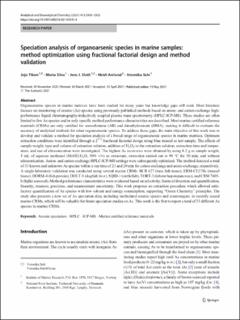Speciation analysis of organoarsenic species in marine samples: method optimization using fractional factorial design and method validation
Peer reviewed, Journal article
Published version
Permanent lenke
https://hdl.handle.net/11250/2977759Utgivelsesdato
2021Metadata
Vis full innførselSamlinger
- Articles [3012]
- Publikasjoner fra CRIStin [3070]
Originalversjon
Analytical and Bioanalytical Chemistry. 2021, 413 (15), 3909-3923. 10.1007/s00216-021-03341-4Sammendrag
Organoarsenic species in marine matrices have been studied for many years but knowledge gaps still exist. Most literature focuses on monitoring of arsenic (As) species using previously published methods based on anion- and cation-exchange high-performance liquid chromatography-inductively coupled plasma mass spectrometry (HPLC-ICP-MS). These studies are often limited to few As species and/or only specific method performance characteristics are described. Most marine certified reference materials (CRMs) are only certified for arsenobetaine (AB) and dimethylarsinate (DMA), making it difficult to evaluate the accuracy of analytical methods for other organoarsenic species. To address these gaps, the main objective of this work was to develop and validate a method for speciation analysis of a broad range of organoarsenic species in marine matrices. Optimum extraction conditions were identified through a 27–3 fractional factorial design using blue mussel as test sample. The effects of sample weight, type and volume of extraction solution, addition of H2O2 to the extraction solution, extraction time and temperature, and use of ultrasonication were investigated. The highest As recoveries were obtained by using 0.2 g as sample weight, 5 mL of aqueous methanol (MeOH:H2O, 50% v/v) as extractant, extraction carried out at 90 °C for 30 min, and without ultrasonication. Anion- and cation-exchange HPLC-ICP-MS settings were subsequently optimized. The method detected a total of 33 known and unknown As species within a run time of 23 and 20 min for cation-exchange and anion-exchange, respectively. A single-laboratory validation was conducted using several marine CRMs: BCR 627 (tuna fish tissue), ERM-CE278k (mussel tissue), DORM-4 (fish protein), DOLT-5 (dogfish liver), SQID-1 (cuttlefish), TORT-3 (lobster hepatopancreas), and CRM 7405-b (hijiki seaweed). Method performance characteristics were evaluated based on selectivity, limits of detection and quantification, linearity, trueness, precision, and measurement uncertainty. This work proposes an extraction procedure which allowed satisfactory quantification of As species with low solvent and energy consumption, supporting “Green Chemistry” principles. The study also presents a new set of As speciation data, including methylated arsenic species and arsenosugars, in recently issued marine CRMs, which will be valuable for future speciation studies on As. This work is the first to report a total of 33 different As species in marine CRMs.
